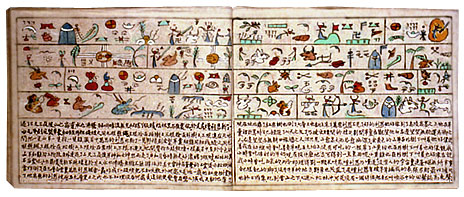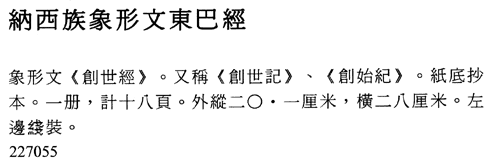 |
|
|
 |
|
|
Dongba Text of
the Naxi People in Pictographic Script People's
Republic (1949�present), dated 1950 Annals of Creation in Pictographic
Script, with Accompanying Translation in Chinese Manuscript
of 18 double leaves, ink and color on paper, stitchbound on left side; each
leaf: approx. 20.1 x 28.0 cm Naxi pictographic script on upper register of each leaf, divided into 4 horizontal rows; each row is subdivided at irregular intervals with single or double lines; Chinese translation on lower register in 5 to 8 horizontal rows Inventory number: 227055 Naxi
pictographic script, said to have been invented by King Moubao Azong in the
thirteenth century, is made of tiny stylized drawings of people, animals,
plants, and so forth.� Like Tibetan, it
is written horizontally and is read from left to right.� The script was invented for exclusive use by
the dongba
(priests) to aid in the recitation of ritual texts during funerary rites,
religious ceremonies, and shamanistic rituals as it did not have the tonal
shortcomings of the earlier phonetic script.�
Most elements of the script are associated with a concept, not a sound,
and not every word has to be written down, only as much as is needed to remind
the reader of the text's contents. The
Annals of
Creation is a Naxi creation myth that is above all a ritual
text.� It is best comprehended as a
magic formula by which the power of the Word replays and consequently recreates
the origins of the world, reproducing the good things of life (such as the Naxi
people) and keeping the evil elements (such as ghosts and demons) at bay.� It is a wonderful epic poem recited in
five-syllable verses that tells not only of the things in the Creation but of
all human feelings, power, desire, fear and hope and combines moments of
majestic drama with pathos, suspense, and humor. |
 |